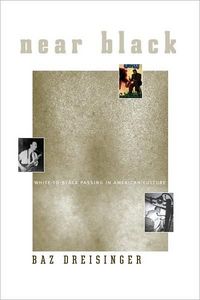

Purchase
White-to-Black Passing in American Culture
Universe
November 2008
On Sale: October 31, 2008
224 pages
ISBN: 1558496750
EAN: 9781558496750
Paperback
Add to Wish List
Non-Fiction
In the United States, the notion of racial passing is
usually associated with blacks and other minorities who
seek to present themselves as part of the white majority.
Yet as Baz Dreisinger demonstrates in this fascinating
study, another form of this phenomenon also occurs, if less
frequently, in American culture: cases in which legally
white individuals are imagined, by themselves or by others,
as passing for black. In Near Black, Dreisinger explores
the oft-ignored history of what she calls reverse racial
passing by looking at a broad spectrum of short stories,
novels, films, autobiographies, and pop-culture discourse
that depict whites passing for black. The protagonists of
these narratives, she shows, span centuries and cross
contexts, from slavery to civil rights, jazz to rock to hip-
hop. Tracing their role from the 1830s to the present day,
Dreisinger argues that central to the enterprise of reverse
passing are ideas about proximity. Because blackness, so to
speak, is imagined as transmittable, proximity to blackness
is invested with the power to turn whites black: those who
are literally near black become metaphorically near black.
While this concept first arose during Reconstruction in the
context of white anxieties about miscegenation, it was
revised by later white passers for whom proximity to
blackness became an authenticating badge. As Dreisinger
shows, some white-to-black passers pass via self-
identification. Jazz musician Mezz Mezzrow, for example,
claimed that living among blacks and playing jazz had
literally darkened his skin. Others are taken for black by
a given community for a period of time. This was the
experience of Jewish critic Waldo Frank during his travels
with Jean Toomer, as well as that of disc jockey Hoss
Allen, master of R&B slang at Nashville s famed WLAC radio.
For journalists John Howard Griffin and Grace Halsell,
passing was a deliberate and fleeting experiment, while for
Mark Twain s fictional white slave in Pudd nhead Wilson, it
is a near-permanent and accidental occurrence. Whether
understood as a function of proximity or behavior, skin
color or cultural heritage, self-definition or the
perception of others, what all these variants of reverse
passing demonstrate, according to Dreisinger, is that the
lines defining racial identity in American culture are not
only blurred but subject to change.
Comments
No comments posted.
Registered users may leave comments.
Log in or register now!
| 


 © 2003-2025 off-the-edge.net
all rights reserved Privacy Policy
© 2003-2025 off-the-edge.net
all rights reserved Privacy Policy